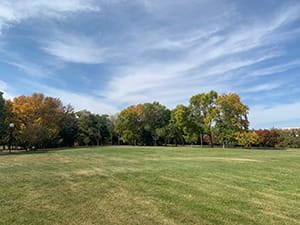REGINA — A notable feature of the 2023 growing season was the extensive wildfire smoke wafting over the province for prolonged periods.
Many growers are wondering about its impact on crops and perennial plants. No specific, scientific investigations were launched to measure the range of impacts, however, numerous plant responses to smoke are known and plant health was monitored for those reactions. Chemical composition and smoke density vary, as do plant genetics and their physiological ability to respond to stressors. Since most of the forest fires were distant and weather patterns were inconsistent, exposure was generally not strong enough (or sustained long enough) to cause observable or economic damage. White beans are known to be particularly sensitive to some components of smoke, so they are more likely to have been negatively impacted than other crops.
Some beneficial effects from smoke coverage likely occurred since drought was a serious concern and smoke has a shading effect through dispersal of solar radiation. Diffusion of solar radiation helps soften light and reduces temperature buildup which can help lower evaporation of soil moisture. In this way, if we didn’t have smoke coverage, the impact of dry conditions in some areas of the province could have been more significant. Some plants are also better enabled to increase photosynthesis through light diffusion, improving penetration of solar radiation into the inner plant canopy, although heavy smoke conditions tend to reduce photosynthesis. The shading and diffusion effects of smoke are like photo-selective netting, a type of crop cover that can be purchased with different capacities to provide shade and different colour selections that alter the light spectrum for the crops growing underneath them. Nets described as “pearl” coloured, cause light scattering like medium-density smoke and are noted for increased branching, improved yield potential and crop quality (Shahak et al. 2008).
Chemical components of smoke like ethylene (C2H4) and ozone (O3) also induce important plant responses. Ethylene is often thought of as a plant senescence hormone, since it plays a role in plants changing the colour of their leaves, in development of abscission when plants drop leaves and fruit and development of dormancy. Fruit from some plants, like bananas and apples continue to ripen after they have been harvested and an increase in respiration rate occurs with these types of fruit when exposed to ethylene. The reaction is used in banana storage rooms to improve taste, texture and colour making the bananas sweeter, smoother and yellower. In apple storage, ethylene is removed or scrubbed to ensure the respiration rate of the fruit remains low to retain crop quality while it is in storage. Increased plant exposure to ethylene in the field can cause more rapid fruit maturation and has been noted to shorten production seasons by five to seven days. In some crops, exposure can cause reduction in C02 assimilation that inhibits growth. Multiple factors were feeding into growth dynamics of crops in 2023, but ethylene from smoke may have played a role in compressing the season, shortening some crops and inducing early yellowing of leaves in perennial plants.
Ozone (03) is a naturally occurring reactive oxygen species (ROS) found at elevated levels in smoke and its impact depends on concentration. Since it is a strong oxidizer, ozone above 0.1 parts per million can cause death of plants and animals. However, at lower concentrations, it can be beneficial and inhibit some fungal and bacterial spread. Reactive oxygen species like ozone cause plants to adjust metabolism when they are under stress, through complex regulation of stress acclimation transcription and translation proteins and enzymes. Some of the proteins and enzymes trigger signalling pathways that can alter gene expression. For example, some plants can be triggered to produce a thicker waxy cuticle on the upper leaf surface which allows them to better endure drought conditions, others may improve salt tolerance (or various other beneficial physiological responses). On the other hand, if ozone concentration is slightly too high, it can cause bronzing or bleaching of upper leaf surfaces which greatly reduces plant health. Leaf bronzing or bleaching from smoke was not observed in Saskatchewan.
Overall, the impact of smoke is not believed to have caused significant economic damage to plants. However, plant health will continue to be monitored this Fall and into Spring of 2024 to determine if longer-term effects have occurred. Growers are encouraged to provide photos of suspected smoke-damaged plants to Forrest Scharf.
— Forrest Scharf, PAg, is a Provincial Specialist – Fruit Crops, Crops and Irrigation Branch, Regina
Bookmark SASKTODAY.ca, Saskatchewan's home page, at this link.




